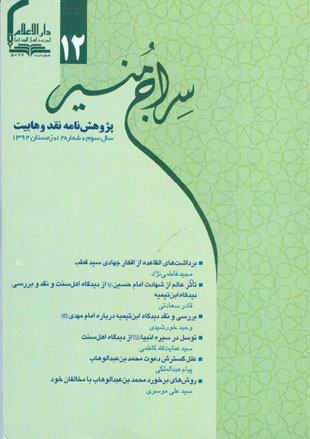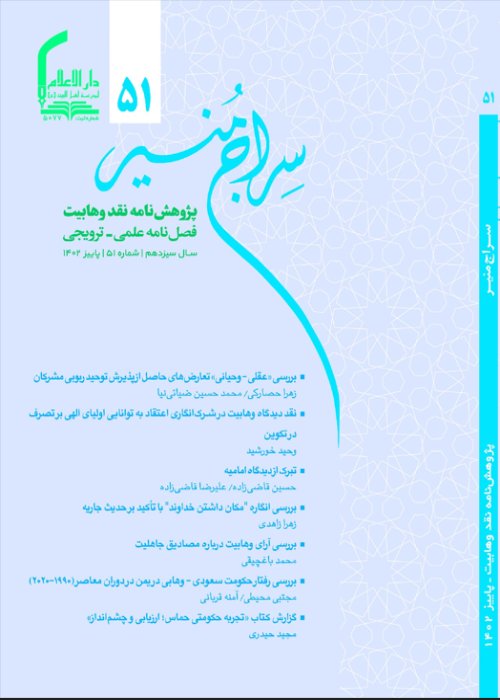فهرست مطالب

نشریه سراج منیر
سال سوم شماره 12 (زمستان 1392)
- بهای روی جلد: 50,000ريال
- تاریخ انتشار: 1393/02/15
- تعداد عناوین: 10
- سرمقاله
-
صفحه 7
- گفتگو
-
علل و عوامل سیاسی برآمدن وھابیت در اسناد امپراتوی عثمانی / در مصاحبه با سید علی موجانیصفحه 11
- مقالات
-
صفحه 31سید قطب یکی از نظریه پردازان بزرگ جمعیت اخوان المسلمین مصر است که توانست با نوشتن کتاب هایی چون تفسیر فی ضلال القرآن و معالم فی الطریق، افکار خود را بین جوانان و نوجوان مصری رواج دهد. وی با قلم شیوا و روان در طرح برخی از مسائل چون عدالت اجتماعی در اسلام، جاهلی بودن مردم در عصر حاضر و تقسیم جهان به دارالاسلام و دارالکفر، طاغوت بودن تمام حکومت ها را مطرح و راهکار آن را جهاد یا هجرت اعلام کرد. بیان این گونه افکار تاثیرات شگرفی در جوانان عرب نهاد؛ به طوری که پس از اعدام وی، گروه های جهادی از جمله القاعده تشکیل شدند که غالبا متاثر از افکار او بودند. آنها در فکر و روش خود پیرو سید قطب بودند، ولی در فقه و اعتقادات از سلفیون چون ابن تیمیه تقلید می کردند؛ همان طور که عبدالله عزام می گوید: من شاگرد چهار نفر بوده ام: در فکر شاگرد سید قطب، در فقه شاگرد نووی، در اعتقادات شاگرد ابن تیمیه و در مسائل روحی شاگرد ابن قیم.[1] بنابراین القاعده یک گروه تلفیقی است که استراتژیک خود را از افکار سید قطب و اعتقادات خود را از ابن تیمیه اخذ کرده است و امروزه شاهدیم که وهابیت با سوءاستفاده از نظریات قطبی، جوانان عرب را به جنگ و جهاد دعوت می کند، ولی با اهدافی خاص که هیچ یک با اهداف سید قطب مطابقت ندارد.
کلیدواژگان: القاعده، سید قطب، وهابیت، جاهلیت، تکفیر، دارالاسلام، دارالکفر -
صفحه 53بعد از شهادت امام حسین(علیه السلام)، اتفاقات عجیبی در عالم رخ داد که نشان دهنده عظمت جنایت و حاکی از غضب الهی بود. هر یک از موجودات عالم به حسب خلقت خود در سوگ شهادت امام حسین(علیه السلام)، ابراز تاثر و حزن کردند. این عجایب علاوه بر اینکه در کتب شیعه آمده، در کتب اهل سنت نیز وارد شده است. ابن تیمیه مانند بقیه فضایل اهل بیت(علیه السلام)، این معجزات را نیز بدون دلیل انکار کرده است و گریه موجودات بر امام حسین(علیه السلام) و سرخی آسمان و باران خون و... را کذب دانسته است، ولی بر خلاف گفته او، این اتفاقات در کتب اهل سنت که مورد استناد و اعتماد ابن تیمیه هم هستند، با طرق متعدد ذکر شده اند و امکان وقوع آنها با آیات و روایات اثبات می شود.
کلیدواژگان: امام حسین(علیه السلام)، معجزه، عاشورا، ابن تیمیه -
صفحه 71ابن تیمیه با صحیح دانستن روایات مربوط به حضرت مهدی(ع)، عقیده مهدویت را از اصول مسلم دانسته است، اما وی با طرح مسائل و شبهاتی مانند عقیم بودن امام عسکری(علیه السلام)، عدم امکان طول عمر برای حضرت مهدی(ع) و عدم توانایی حضرت مهدی(ع) برای امامت و رهبری درکودکی سعی کرده است تا اعتقاد به مهدی موعود در نزد شیعیان را اعتقادی موهوم و پوچ جلوه دهد. نویسنده ضمن نقل دیدگاه ابن تیمیه درباره اصل مهدویت، درصدد طرح اشکالات ابن تیمیه و پاسخ گویی به این اشکالات نیز برآمده است. در پاسخ به شبهه عقیم بودن امام عسکری(علیه السلام) بیان شده است که ابن تیمیه این مطلب را به طبری نسبت داده است؛ درحالی که در هیچ کجای کتاب تاریخ طبری به عقیم بودن آن حضرت اشاره نشده است. همچنین به ادعای ابن تیمیه درباره محال بودن طول عمر امام مهدی(ع) پاسخ گفته و لیاقت، کمال و رشد فکری را شرط امامت دانسته، نه سن را.
کلیدواژگان: ابن تیمیه، امام مهدی(ع)، احادیث مهدویت، طول عمر، امامت -
صفحه 95با تتبع در منابع اهل سنت هویدا می گردد که وقوع و جواز توسل در سیره انبیای الهی به صورت یک سنت رواج داشته است. وقوع موارد متعدد توسل به ساحت انبیا و اولیای الهی، نشانه قدمت توسل و مستحکم ترین دلیل بر صحت و مشروعیت آن است. این نوشته به روش توصیفی تحلیلی عهده دار بیان مواردی از توسل در سیره انبیا با تاکید بر منابع اهل سنت است که هم شامل توسلات انبیای الهی و هم شامل توسلات سایرین به انبیاست. بخش بزرگی از این توسلات در توسل به پیامبر اعظم(صل الله علیه و آله و سلم) متجلی می گردد. برخلاف متون روایی امامیه، موارد توسل در سیره انبیا در متون اهل سنت کمتر ذکر شده است. با این حال موارد متعددی از توسل به پیامبر(صل الله علیه و آله و سلم) را نقل کرده اند و در پاسخ به شبهات مطرح شده در ابعاد مختلف توسل، تلاش ها و تحقیقات علمی درخوری داشته اند.
کلیدواژگان: توسل، استغاثه، سیره انبیا، آدم، ابراهیم، موسی، اهل بیت(علیهم السلام) -
صفحه 121جهان اسلام سال هاست که شاهد جریانی به اصطلاح سلفی به نام وهابیت است که سراسر سرزمین وحی را در برگرفته است. تفکر وهابیت تاثیر فراوانی در منطقه و جهان اسلام داشته است. یکی از مباحثی که در مطالعه جریانات مختلف نقش به سزایی دارد، روشن شدن علل رشد و توسعه آنهاست. در این زمینه قصد داریم با توجه به مدارک تاریخی به بررسی علل گسترش این پدیده نوظهور بپردازیم.
کلیدواژگان: وهابیت، محمد بن عبدالوهاب، آل سعود، استعمار -
صفحه 141این مقاله با محور قرار دادن نامه ها و احتجاجات محمد بن عبدالوهاب، به بررسی شیوه های او در احتجاجات و ارتباط با مخالفان و تبلیغ عقاید خویش می پردازد. روش های عملی مانند جنگ ها و کشتارها و جنایت ها در این مقاله مد نظر نیست که آن خود بحث مفصلی را می طلبد، بلکه به ذکر برخوردهای به ظاهر علمی و اخلاقی او با مخالفان می پردازیم. وی با استفاده ابزاری از قرآن و سنت، مردم را به سمت خود می خواند و هرگونه مخالفی را مشرک و جنگ با او را واجب می دانست. تکفیر عموم مردم مسلمان زمان خود، به کاربردن تعبیرات زشت و ناروا در مورد علمای مخالف و تطبیق آیات نازل شده در شان مشرکین بر مسلمین زمان خود از ویژگی های روش اوست؛ به طوری که مسلمانان زمان خود را از کفار صدر اسلام هم گمراه تر می دانست.
کلیدواژگان: محمد بن عبدالوهاب، تکفیر، احتجاجات ابن عبدالوهاب، نامه های ابن عبدالوهاب - گزارش ها
-
سلسله گزارش ھایی از آثار اھ لسنت در نقد افکار وھابیت (9) / گزارش کتاب «اتحاف الزائر و إطراف المقیم للسائر»صفحه 157
-
صفحه 167
-
Page 31Seyyed Qotb is one of the great theorists in Ikhwan al- Muslimin (The Muslim Brotherhood) group. He develops his ideas and thought among youth and young adults through writing some books such as: “Fi Zelal al- Quran” and “Maalem fi al-Tarigh”. He states some issues such as social justice in Islam, current ignorance of people, division of the world to two parts: Islamic part (house) and disbelief part (house), and named all governments Devil, finally he introduced Jihad (holy war) or Hijrat (holy emigration) as a solution for them. Expressing such subjects had a noticeable impact on Arab Youth, so that some jihadi groups such as al-Qaede were formed after his execution. They follow seyyed Qotb in method and thought, but in jurisprudence and beliefs follow Wahhabism Salafism scholars such as Ibn Taymiyyah. Likewise, Abdollah Azzam states that I was the student of four teachers; Seyyed Qotb in thought, Navavi in jurisprudence, Ibn Taymiyyah in belief and Ibn Qhayyem in spiritual issues. Therefore, Al- Qaedeh is the mix group which got its strategic concepts from Seyyed Qotb and got their beliefs from Wahhabism. Today we observe that Wahhabism invite Arab youth to war and jihad through abusing Seyyed Qotb ideas, though their goals are not compatible with Seyyed Qotb targets.Keywords: Al, Qaedeh, Seyyed Qotb, Wahhabism, ignorance, Takfir, Islamic part (house), disbelief part (house)
-
Page 53After martyrdom of Imam Hussain some strange accidents happened in the world which showed the depth of that tragedy and crime and indicated Divine wrath. Every creature expressed sorrow and mourned according to its nature for the martyrdom of Imam Hussain. These wonders mentioned not only in the Shia books and documents but also in Sunnite books. Ibn Taymiyyah denied these miracles, the same as other virtues of the Prophet’s Family without any evidence and considered miracles such as: creature crying for Imam Hussain, redness of sky, and blood rain, etc, false. By contrast, such wonders and miracles mentioned in Sunnite books by various narrators and those books are authentic and confirmed by him.Keywords: Imam Hussain, miracle, Ashura, Ibn Taymiyyah
-
Page 71Ibn Taymiyyah confirmed traditions and narrations about Imam Mahdi (a.s.) and considered believing Imam Mahdi (a.s.) as a postulate. But through expressing some dubious things such as: infertility of Imam Ashari (a.s.), impossibility of longevity of Imam Mahdi (a.s.), and incapability of Imam Mahdi (a.s.) for leadership in his childhood, he tried to nominate the belief in Imam Mahdi (a.s.) as a wrong and null belief and hypothesis. The author tries to indicate the Ibn Taymiyyah problems and questions besides their solutions and answers. Answering the Ibn Taymiyyah dubious question about infertility of Imam Asgary (a.s.), the author states this subject is not mentioned in “Tabari History”, though Ibn Taymiyyah claimed it was mentioned there. Also he answer Ibn Taymiyyah’s other claim about impossibility of Imam Mahdi (a.s.) longevity. Then, the writer accounts some features such as: deservingness, accomplishment and intellectual growth as the Leadership (Imamat) conditions but the age.Keywords: Ibn Taymiyyah, Imam Mahdi (a.s.), traditions bout Imam Mahdi (a.s.), generation, longevity, Leadership (Imamat)
-
Page 95Occurrence and license of invocation were found out through studying Sunnite sources and documents as apparent tradition in messengers’ life. The occurrence of multiple cases of invocation to messengers and God Almighty’s friends is the sign if invocation history and is the strongest evidence for its legitimacy. This study tries to express some invocation cases which consist of both messengers’ invocation to God Almighty and the people invocation to the messengers in their life through descriptive analysis method according to Sunnite documents. The great part of these cases belongs to invocation to the holy Prophet (p.b.a.h.). Unlike Shia tradition, Sunnite tradition narrates few invocation cases in messengers’ life. However, several cases of invocation to the holy Prophet (p.b.a.h.) have been narrated and also some valuable studies and efforts to answer to the raised questions on various aspects of invocation have been conducted.Keywords: invocation, supplication, messenger's manner, Adam, Abraham, moss, the Prophets Family
-
Page 121The Islamic world has been observed the Salafi School called Wahhabism which encompass the revelation territories for years. The Wahhabism thought has been had a great impact on the region and Islamic world. One of the factors which has a remarkable role in studying the schools and doctrines is clarifying the reasons of their development and growth. In this study the author tries to investigate the reasons for the development of this emerging phenomenon according to historical documents.Keywords: Wahhabism, Muhammad Ibn Abdul Wahhab, reasons of development, Al, Saud, Colonialism (Imperialism)
-
Page 141Concentrating on letters and debated of Muhammad Ibn Abdul Wahhab, this study investigates methods of his debates, dealing with his dissidents, and his belief propaganda. In this study his practical methods such as: wars, slaughters, crimes are not concerned because such methods need long discussion, but his apparent scientific and ethical approach with his dissent is focused. Abusing the holy Quran and Islam tradition, he invite people to himself and considers all of his opposites as pagans and declared fighting with them is necessary. Anesthetizing most of his contemporary Muslims, using dirty expressions and terms about opposite scholars, and adopting some Quranic verses about pagans for his contemporary Muslims, are some features of his method; as far as, he considered his contemporary Muslims more astray than the pagans at the beginning of Islam.Keywords: Muhammad Ibn Abdul Wahhab, anathemas, Ibn Abdul Wahhab debates, Ibn Abdul Wahhab letters


